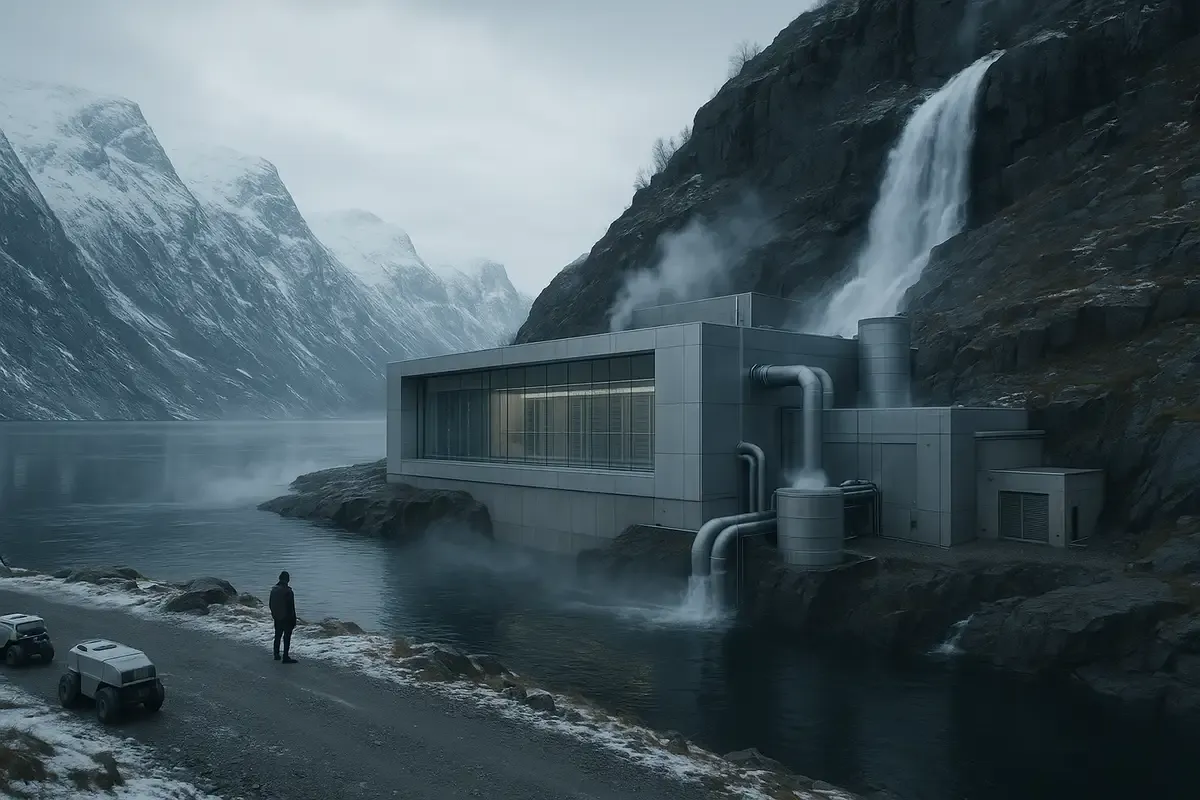💡 TL;DR - The 30 Seconds Version
👉 OpenAI announces $1 billion Norwegian data center targeting 100,000 NVIDIA GPUs by 2026, marking its first European facility under the Stargate program.
📊 Tech giants plan $300+ billion in AI infrastructure spending for 2025 alone, with McKinsey predicting $5.2 trillion needed by 2030.
🏭 The Kvandal facility will run on 230 megawatts of renewable hydropower with closed-loop cooling, expandable to 520 megawatts total capacity.
🌍 Europe launches €20 billion "AI gigafactory" program as nations race to build sovereign AI infrastructure independent of US and China.
🚀 Norway's cheap energy and cold climate offer sustainable alternative to water-guzzling facilities in drought-prone Texas and Arizona.
💡 Critics question whether the global AI infrastructure arms race makes economic sense, calling it a "mass hallucination" based on unproven returns.
OpenAI just picked one of the coldest places in Europe to build one of its hottest data centers.
The company announced Thursday it's launching Stargate Norway, a $1 billion AI facility targeting 100,000 NVIDIA GPUs by 2026. The site will sit in Kvandal, just outside Narvik in northern Norway, where cheap hydropower meets Arctic air - conditions that suddenly look perfect for AI infrastructure.
This marks OpenAI's first European data center under its "OpenAI for Countries" program, a 50-50 joint venture between British startup Nscale and Norwegian energy firm Aker. The initial 230 megawatts of capacity could expand to 520 megawatts, making it among Europe's largest AI facilities.
The Great AI Infrastructure Arms Race
The Norwegian announcement lands amid an unprecedented global spending spree on AI infrastructure. Microsoft, Alphabet, Amazon and Meta plan to pump more than $300 billion into data centers in 2025 alone. Total data center spending this year could hit $475 billion, up 42% from 2024.
McKinsey predicts the world needs $5.2 trillion in data center investment by 2030. Meta's Mark Zuckerberg talks about "hundreds of billions of dollars" to build superintelligence, with data center clusters large enough to cover Manhattan. Each facility gets named after Greek Titans, because apparently regular names don't capture the scale.
The numbers feel almost fictional. Oracle plans to deliver 400,000 NVIDIA GPUs to OpenAI's Texas facility at roughly $40 billion. Amazon is building a 2.2-gigawatt site in Indiana. Elon Musk's xAI targets 1.2 gigawatts across Memphis.
"I don't know any company, industry or country who thinks that intelligence is optional," NVIDIA CEO Jensen Huang said in May. "We're clearly in the beginning of the build-out of this infrastructure."
Why Norway Works
The Kvandal location has everything AI data centers need. Abundant hydropower. Low electricity prices. Limited local demand for that power. Cold weather for natural cooling. Norway built its economy on cheap energy - first aluminum, then fertilizer, now AI.
The facility will run on renewable energy with closed-loop cooling that recycles excess heat to nearby businesses. Compare that to facilities in Texas and Arizona that drain water supplies and strain power grids during heat waves.
"Norway has a proud history of turning clean, renewable energy into industrial value," said Øyvind Eriksen, Aker's CEO. Norway ran aluminum smelters and fertilizer plants for decades on cheap hydropower. Now it's applying the same model to AI.
The timing matches Europe's push for "sovereign AI" - keeping data processing inside European borders under European rules. The EU announced a €20 billion program for AI "gigafactories." France plans a 1.4-gigawatt campus near Paris. The UK promises 500-megawatt "AI Growth Zones."
The Heat Problem Nobody Talks About
Behind the breathless expansion announcements lies a brutal technical reality: AI chips generate enormous heat. Modern AI processors consume at least 10 times more power than regular servers, with NVIDIA's latest chips requiring "direct to chip" cooling where coolant flows through metal plates attached to processors.
Traditional air conditioning can't handle the load. Data centers now dedicate 70% of their footprint to cooling and power equipment, completely inverting the old model where servers filled most of the space.
The cooling challenge has pushed operators toward liquid cooling systems that can churn through 19,000 liters of water per minute. Some facilities use closed-loop systems with industrial chillers - essentially building-sized refrigerators.
"Everything has been turned upside down," said Steven Carlini from Schneider Electric, a major data center supplier.
The Scaling Law Bet
All this spending rests on one core belief: that more data and computing power will deliver more intelligence indefinitely. It's called the "scaling law" of AI, and it's driving decisions to build facilities that would have seemed absurd just years ago.
OpenAI's Sam Altman envisions facilities "way beyond" 10 gigawatts of power. NVIDIA's roadmap shows single server racks consuming 600 kilowatts within two years - enough to power 400 homes.
But some question whether this endless race makes sense. Sasha Luccioni from Hugging Face calls it "almost like a mass hallucination where everyone is on the same wavelength that we need more data centers without actually questioning why."
Alternative approaches like model distillation and smaller, more efficient designs are gaining traction. DeepSeek's efficient model earlier this year briefly spooked investors who wondered if the industry was overspending on massive facilities.
Building Tomorrow's Problems Today
The infrastructure boom creates cascading challenges. Virginia utilities dealt with sudden power surges when AI facilities switched to backup generators simultaneously. Georgia residents complain that Meta's development damaged water wells and pushed up municipal costs.
Data centers consumed 55 billion liters of water directly in the US during 2023, plus 800 billion liters indirectly through energy production - equivalent to almost 2 million homes' annual usage.
Microsoft sources 42% of its water from "areas with water stress." Google pulls almost 30% from watersheds with medium or high risk of scarcity. The race for computing power is colliding with basic resource constraints.
Yet the building continues unabated. "At some point, will it slow down?" asks Mohamed Awad from chip designer Arm. "It has to. But we don't see it happening any time soon."
Why this matters:
• The Norwegian facility represents a new model for sustainable AI infrastructure, but it's just one project in a global arms race that's consuming unprecedented resources based on unproven returns.
• Europe is betting billions on "sovereign AI" to avoid dependence on US and Chinese infrastructure, turning data centers from cost centers into geopolitical assets.
❓ Frequently Asked Questions
Q: When will the Norway data center actually start operating?
A: Work starts with a 20MW section, aiming for 100,000 NVIDIA chips by late 2026. No firm launch date yet - they'll expand as customers sign contracts.
Q: How big is 230MW for a data center?
A: It's massive. Traditional data centers use 10-50MW. Meta's Louisiana facility targets 2,000MW, while Amazon's Indiana site aims for 2,200MW. At 230MW expanding to 520MW, Norway would rank among Europe's largest AI facilities.
Q: Why is Norwegian power so cheap?
A: Norway gets 96% of its power from water. The Narvik area has lots of rivers, few local users, and can't easily send power to other countries. This creates a surplus that keeps prices well below European averages.
Q: Who actually owns the Norwegian facility?
A: Nscale and Aker will split ownership 50-50 through a joint venture. OpenAI is an "offtaker," meaning it will buy capacity from the facility rather than own it directly. Each partner committed roughly $1 billion to the initial phase.
Q: How much water will this data center actually use?
A: Norway will use closed systems that recycle coolant, unlike centers that burn through 19,000 liters per minute. They didn't say exact amounts, but heat gets reused by nearby companies.
Q: What do 100,000 NVIDIA chips actually do?
A: They'll train and run AI models for OpenAI and other customers. Training large language models requires thousands of GPUs working together. The facility will also serve European developers, researchers, and startups needing AI computing power.
Q: Why can't existing European data centers handle AI workloads?
A: AI chips consume 10 times more power than regular servers and generate enormous heat. Most existing facilities use air conditioning and weren't designed for such intensive workloads. AI requires specialized cooling and massive power capacity.
Q: Can this Norway model work in other countries?
A: It requires specific conditions: abundant renewable energy, cold climate, available land, and supportive regulations. Iceland, parts of Canada, and some Nordic regions have similar advantages. Most countries lack Norway's hydropower surplus and stable grid.








